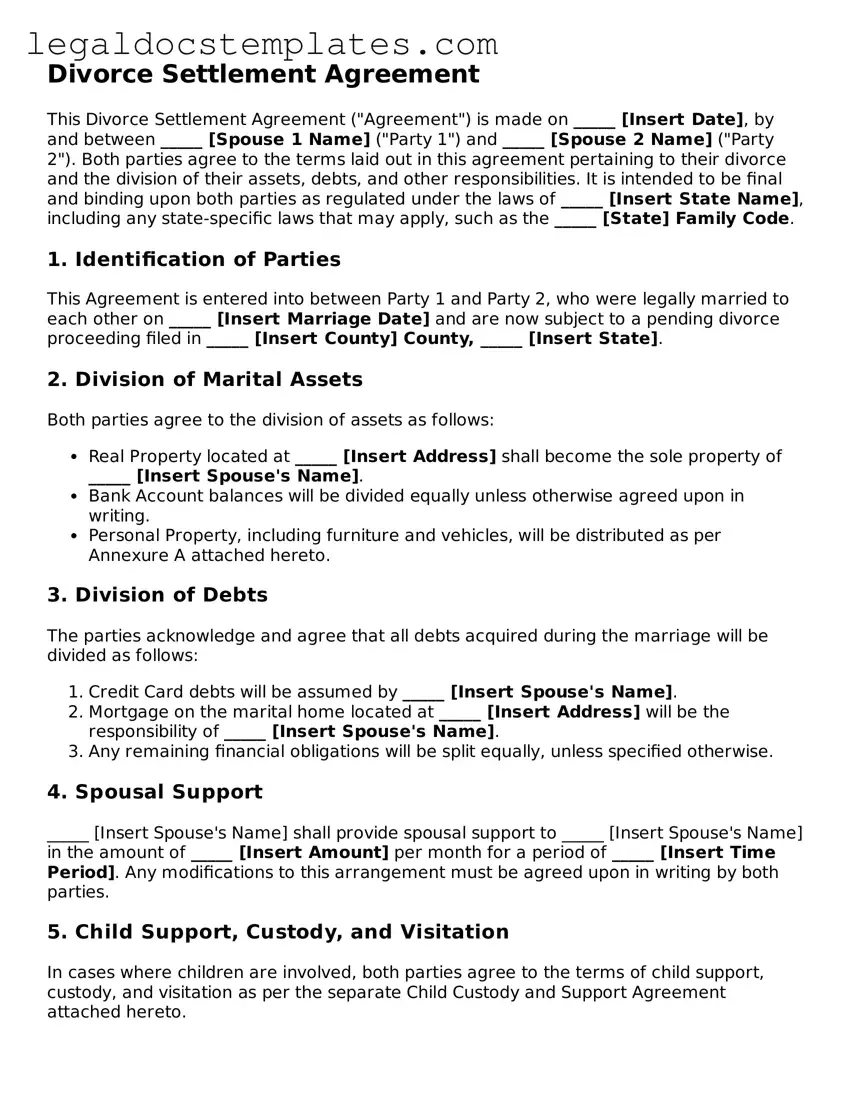Divorce Settlement Agreement
This Divorce Settlement Agreement ("Agreement") is made on _____ [Insert Date], by and between
_____ [Spouse 1 Name] ("Party 1") and _____ [Spouse 2 Name] ("Party 2").
Both parties agree to the terms laid out in this agreement pertaining to their divorce and the division of
their assets, debts, and other responsibilities. It is intended to be final and binding upon both parties as
regulated under the laws of _____ [Insert State Name], including any state-specific laws that may apply,
such as the _____ [State] Family Code.
1. Identification of Parties
This Agreement is entered into between Party 1 and Party 2, who were legally married to each other on _____ [Insert Marriage Date] and are now subject to a pending divorce proceeding filed in _____ [Insert County] County, _____ [Insert State].
2. Division of Marital Assets
Both parties agree to the division of assets as follows:
- Real Property located at _____ [Insert Address] shall become the sole property of _____ [Insert Spouse's Name].
- Bank Account balances will be divided equally unless otherwise agreed upon in writing.
- Personal Property, including furniture and vehicles, will be distributed as per Annexure A attached hereto.
3. Division of Debts
The parties acknowledge and agree that all debts acquired during the marriage will be divided as follows:
- Credit Card debts will be assumed by _____ [Insert Spouse's Name].
- Mortgage on the marital home located at _____ [Insert Address] will be the responsibility of _____ [Insert Spouse's Name].
- Any remaining financial obligations will be split equally, unless specified otherwise.
4. Spousal Support
_____ [Insert Spouse's Name] shall provide spousal support to _____ [Insert Spouse's Name] in the amount of _____ [Insert Amount] per month for a period of _____ [Insert Time Period]. Any modifications to this arrangement must be agreed upon in writing by both parties.
5. Child Support, Custody, and Visitation
In cases where children are involved, both parties agree to the terms of child support, custody, and visitation as per the separate Child Custody and Support Agreement attached hereto.
6. Governing Law
This Agreement shall be governed by the laws of the State of _____ [Insert State], without regard to its conflict of laws principles.
7. Entire Agreement
This document, along with any attachments or annexures, represents the entire agreement between the parties concerning their divorce settlement. Any amendments to this Agreement must be in writing and signed by both parties.
8. Acknowledgment of Terms
Both parties hereby acknowledge that they have read, understood, and agree to the terms contained within this Divorce Settlement Agreement. Each party affirms they are entering into this Agreement voluntarily and without any coercion or undue influence.
IN WITNESS WHEREOF, the Parties have executed this Agreement as of the date first above written.
Party 1: ___________________________________ Date: ___________________
Party 2: ___________________________________ Date: ___________________
Witness: ___________________________________ Date: ___________________
